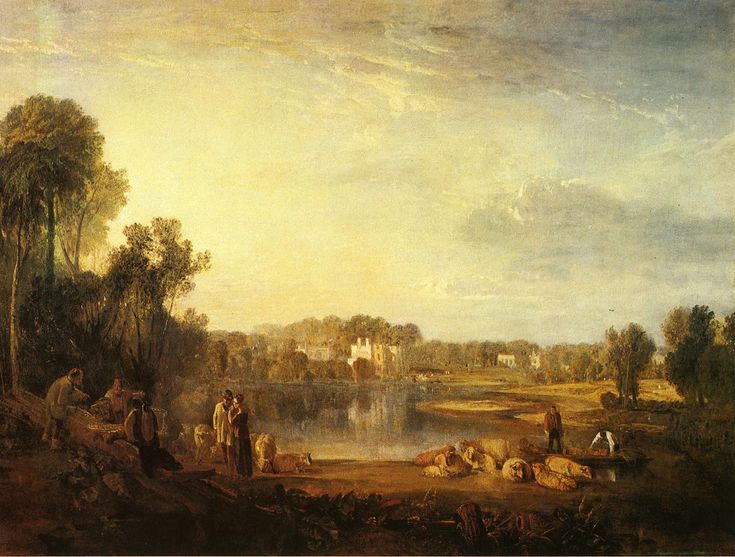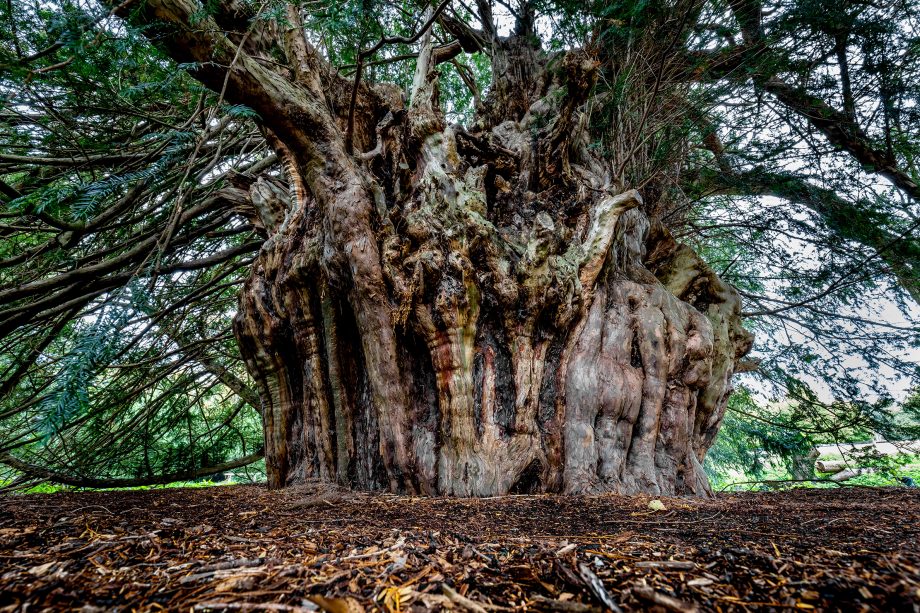Yews in churchyards have long seemed unusual. Even though they are obviously not old at all, they have an air of antiquity, distilled from somber foliage and dark wood; a sensation of being remains or echoes of some bygone business. In the parish churchyard of Berkhamsted, where I grew up, there stood a yew. It was only a stripling when it was 300 years old, and our lecturers said that the mound it was planted on might have once contained the corpses of the town’s plague victims. They never provided an explanation. We used to race over the tiny barrow in hopes of attracting ghosts and adult displeasure.
I would have avoided yews then if I had known that they were originally thought to have vampire-like connections with the dead. In 1664, the imaginative botanist Robert Turner wrote, “If the Yew be set in a place subject to poisonous vapours, the very branches will draw and imbibe them. Hence it is conceived that the judicious in former times planted it in churchyards on the west side, because those places, being fuller of putrefaction and gross oleaginous vapours exhaled out of the graves by the setting sun, and sometimes drawn by those meteors called ignes fatui, have scared divers, thinking some dead bodies walk there.” (This idea was maintained into the twentieth century in an odd reversal. According to Dr. Kukowka, a German medical expert at the University of Greiz, yew trees release gaseous poisons on hot days that might cause hallucinations in those who sit in their shade.)

However, our yew appeared to be a friendly municipal adornment rather than a strange or uncomfortable presence. Located in the heart of the town, near several bars, it served as an obvious destination for partygoers on New Year’s Eve. On December 31, 1976, during the storm, I witnessed the thin, flowing twigs waving over the people along the High Street at midnight. Regardless of its true nature, it appeared to be a friendly kind of tree.
Yews are ancient temperate zone residents, with seven species found in Central America and Asia. For a few million years, give or take the occasional ice age, the European species Taxus baccata has spread from the coast of central Norway to the mountains of north Africa. Archaeological evidence in Britain indicates that yews were widely planted both during and after the glaciers. The oldest surviving wooden artifact in the world is a 250,000-year-old yew spear discovered at Clacton, Essex. Later on, its distribution was limited by climatic change. Massive stumps and trunks that were submerged by the rising water levels around 6000 BC have been found buried in the Fenland peat. As soon as the first farmers arrived 1,000 years later, those on dry land started to disappear; their poisonous foliage was killing livestock.
The word “yew” has echoes in a number of European languages, including Welsh (iw and yw), Dutch (uwe), French (if), and German (if). This suggests that the tree’s significance persisted even as people traveled across the continent. On the other hand, there is scant empirical evidence to bolster the enduring and widely held belief that yews were “sacred,” the objects of veneration in ancient religions. There are a few untrustworthy accounts by Roman commentators, and a few Bronze Age rock sculptures depicting what may be coniferous foliage. In a survey of Anglo-Saxon boundary descriptions for the south of England, yew is not even mentioned as a named tree, making it a significant geographical characteristic. However, as hundreds of ancient yews remain, most likely in their original locations, it was obviously a tree of some significance, as a landmark or meeting point.
Some may have survived because their habitat was inaccessible, like as the dwarfs that cling to the sheer cliff faces of Yew Cougar Scar in the Yorkshire Dales. However, the majority are enigmaticly located in church yards thousands of years younger than them, which is at least a circumstantial suggestion of some sacred purpose in the past. As the ages of these survivors are starting to become known, they pose a major challenge to many of the long-held beliefs about the potential ages of trees. The earliest churchyard yews may have emerged shortly after Britain’s civilized civilization began, and they don’t appear to be close to dying.
But there they remain, topographically intertwined with the far newer structures of our state religion; the untamed and serpentine beside the sedentary and pious. The yews themselves consistently refuse to behave like solemn monuments, and the very existence of these peculiar trees on holy ground raises questions beyond the likely date of their origin, particularly why and how they came to be there. This ancient dance between biology and the social order is going on here.
While researching a biography of Selborne, Hampshire’s most renowned son, naturalist Gilbert White, I encountered the first veteran I personally knew at St. Mary’s Church. Although the Selborne yew was a well-known landmark in the area, it was by no means humble, cathedral-like, or any of the other clichés that so frequently stifle the uniqueness of old trees. Apart from its enormous girth, which measured about twenty-eight feet when it was initially measured, it wasn’t even that large. It grew slowly on the southwest side of the church.
In the 1780s, Hieronymus Grimm depicted a noticeably stumpy growth that was pollarded all the way up to the height of the nearby cottages when he drew an engraving of it for White’s The Natural History of Selborne. After two centuries, it was still fulsome and squat, with the tranquility of a rural alderman. The interior of the trunk was what I cherished the most. Old yews are nearly always hollow, and the Selborne tree’s interior surfaces were patched with a lilac and gray satiny gloss reminiscent of mother-of-pearl shine. That tree was happy. It even featured a seat surrounding it, where one could see the world going by.
The Great Yew at Fortingall, Perthshire, which is situated beside the Victorian church in this small community, is the yew that surpasses all others and is arguably the most renowned and controversial tree in all of Europe. The devout—and it’s not hyperbolic to suggest that disciples of such trees think it has been growing here for at least 5,000 years—believe that. If true, it was thriving long before Stonehenge was built and the Neolithic burial chamber at Maeshowe in the Orkney Islands was excavated.
The Great Yew is the best illustration of the enigmatic union of an ancient tree and a hallowed location in Britain, and contemporary pagans have not overlooked the implications. They contend that the locations of former tree cults were acquired by the Christian church and that the presence of an old yew owned by a church is a surefire indicator of the Old Religion. As a result, a vibrant New Age folklore centered around old yews has emerged.

In particular, the Fortingall tree has become something of a tree goddess, worshipped by nostalgic wood folk, Druid revivalists, and proud Celtic people. Some Christians who are open-minded have even started to mythologize it. According to mythology, Jesus spent his “lost years” there. The axis mundi of the alternative Scotland is Fortingall, where a starburst of ley lines from the Holy Isle of Iona to Montrose (Mount of the Rose), from Eilean Isa (island of Jesus) and the holy island of Lindisfarne intersect.